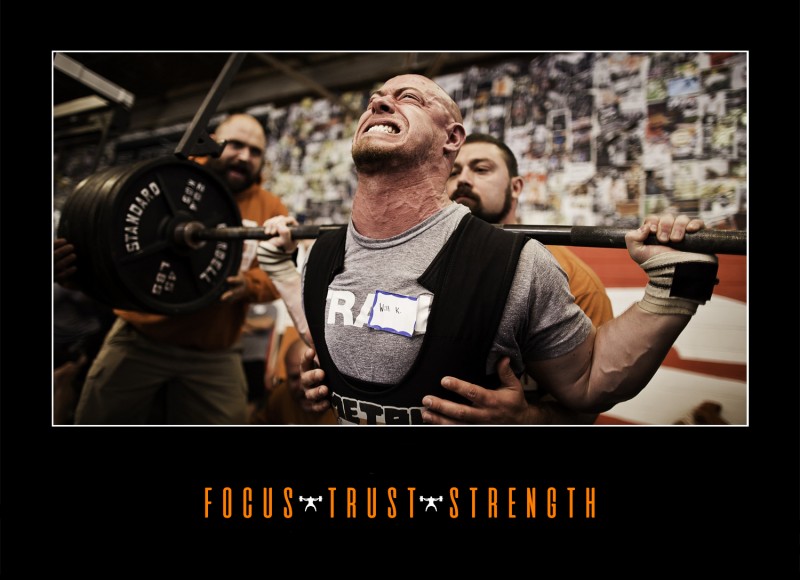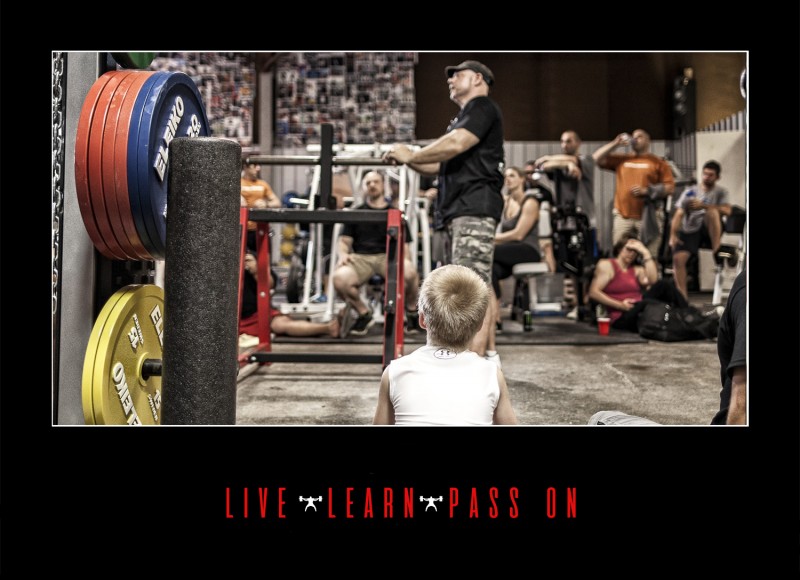
Introduction
Life periodization or staging is something complicated. Historians periodize stages in the history of societies, ideas, communities, habits and lots of other subjects that change in time.
All historical patterns are a product of chance and necessity: a predictable development of something. Chance plays a greater role in individual lives. Billions of unpredictable individual stories create the patterns that science – history, sociology, political science, economy – will study. Individual lives are messy.
That doesn’t mean there are no patterns. There are, and that is what gives you a modicum of control over your life.
RECENT: Squatting from Womb to Tomb: Why You Must Train 'Til You Die
Although I tried hard to follow the main road, I kept being pushed to the very less traveled ones and the result is a psychedelic picture. A couple of times I had people tell me that the amazing thing about my life was not what I did, but the story itself. “Your greatest accomplishment is your biography”, said a friend who is quite accomplished in finding patterns: she is an economist. “Quit all this shit you’ve been doing and write a book about your life: that will be a bestseller and you will make money," said another friend who is brilliant in a unique way: he has the Midas touch.
It may be fascinating from the outside but from where I stand, not at all: it’s exhausting and very confusing. I have to admit, though, that I’m not only a bit out of the ordinary but also a weirdness magnet.
This article is about this most recent stage of my adventure on the planet, when I joined team elitefts. Lots of other things happened in this period but my story with elitefts created a timeline and that is what I will share, hopefully with useful items or at least entertainment. It is a story about grounding and shelter. Everything else is a consequence.
Before the storm: elitefts
My story with elitefts is mostly about my interaction with two people: Dave Tate and Sheena Leedham. Before I exchanged any words with these people, though, there was a story in the making. It started in 2007 when I was learning about strength training and the strength sports. It was the second year of a new life, a new me, a person acquiring the new set of skills and cognitive tools to understand this new world. elitefts was receiving applications for athletic sponsorship. A short “job description” for applicants emphasized “communication skills”.
Having come from a strict academic environment where I worked and lived for decades, I made several mistakes during that transition period. There was too much I didn’t know about the new environment and I failed to see that I needed to learn as fast as possible: “recon” or take the blow. One thing, though, was easy enough: the basic structure of the fitness industry. I figured out right away the foundations of its persuasive discourse, the marketing jargon, values, symbols, and messages. Discourse analysis was one of the chapters of my dissertation and a persuasive discourse is a persuasive discourse, whether to sell beer, soap, body perceptions, politicians or ways of life.
That company (elitefts) wanted to sponsor people to speak to an actual and potential audience. That was unusual in a world of very strictly formatted and shallow communication. Why would they stand out?

At the time, only a few platforms were considered reliable sources of training information, elitefts being one of them. Later, others came up. I discovered Powerlifting Watch because they discovered me: something I published on my blog was re-published there. It wasn’t that hard to prune out the less relevant outlets.
elitefts was on my radar for several reasons but still not the ones most people would imagine. It was at the same time the unexpected and innovative approach to things we had little understanding of and the bright toys. Yes, the bright toys, the power racks were and remain an object of fascination for me.
At some point, I believe around 2009 or 2010, Dave published something on the “injured – hurt – fucked-up” typology. That was a bunch of brand-new rabbit holes for me to crawl into. Pain science was and still is expanding its conceptual and empirical domain and sports psychology is still struggling with its identity.
My actual first contact with the company, through Dave, is directly related to that sponsorship application ad. That ad pushed me to study and understand what sports sponsorship was. That was how I became responsible for the sponsorship project of a powerlifting event. I created different sponsorship classes associated with different activation actions. I wrote to Dave to inquire about his willingness to sponsor the event and what we could offer elitefts, which wasn't much. He was on-board, the last edition of that event took place, and I had little contact with most people involved in it afterward.
Before I let it all go, I asked Dave if he would like to read some of my stuff and whether he would be interested in my contribution. I was transitioning in many respects and I knew how important it was for a writer, whether a fiction writer, a science education writer or a scholar, to have a home. I had homes in the past, homes I loved but I was now speaking to a different audience, in a different language, about different subjects. I liked the way the content was presented at elitefts, its quality, but mostly it was Dave’s no-bullshit approach that attracted me.
It was the end of 2015 and my records show the earliest contract in March 2016. I think I spoke to Sheena on the phone sitting on the couch at my house in Brazil, probably before October 2015.
In January 2016 everything fell apart. Chance, that bitch, and other things. I found myself fully transitioned to the USA, in complete chaos and no clue what my life would look like from then on.
I did have grounding and shelter, though.
Grounding, shelter, structure
The concept of “grounding” in psychology is not even controversial: it’s polysemic. It means different things to different schools of thought that sometimes don’t even bother to interact (Miller 1994, Pecher & Zwaan 2005, Williams & Gantt 1998). Let’s assume that the “self” defining a person is “grounded” on a certain set of symbolic pillars: their cultures (today a single individual may share multiple cultures or sub-cultures), their affects, their values, their social networks, their language, etc. The person functions within this symbolic and physical environment. When an individual is suddenly uprooted and loses many of their links to that environment, a lot of damage may be caused. In many cases, the individual is destroyed.
When the basic pillars of a person’s life are shattered, destroyed or radically redefined – place, family, work, culture – no matter how solid their principles and moral code are, they will eventually fall. Here is the problem: these higher hierarchy items of a person’s identity and motivational architecture don’t hang from the sky. They don’t hang at all: they are pillars, therefore, something rooted on a ground.
A life-shattering event could be metaphorically represented by a bombarded area where few things remain standing. They don’t make much sense in that landscape anymore. That’s all the survivor has to hang on to rebuild something. With no roof to shelter the survivor from further damage, they will perish.
That’s what elitefts provided me with: grounding and a home. Everything had been uprooted including my professional identity. My relationship with powerlifting became the upside-down world, a horror movie, before it could be redefined. The only way to accomplish such a herculean task of rebuilding a life from scratch is through grounded discipline: I had a schedule to deliver one column article per month and once a month I faced the strength training Sphinx. Each month I answered her riddle and survived another month.
Some riddles were rabbit holes too deep for me to crawl back from. I had to change the subject of the article and the Sphinx, like the original Egyptian one, was benevolent. It still guarded the gates to Meaning and Purpose but I always had another chance.
Both Sheena and Dave gave me a lot of freedom there. None of my articles has 1500 words. They are much longer but I suppose they knew I needed that.
I was hanging from what was left of my previous life landscape through the elitefts column. During these three years, I did make decent progress towards rebuilding meaning and purpose.
The autism connection
The autism connection was a strong part of my relationship with elitefts. I read Dave’s journal on his journey as a parent and I learned about Sheena’s work. Although neither my father nor I were officially diagnosed as autistic, it was suggested by several psychiatrists that worked with me that we were. When I learned more about this “umbrella condition”, my father was already over 90 years of age (he is now 95). It doesn’t make any sense to get him tested. In the end, considering all I’ve learned, it didn’t make sense for me to go through all the trouble to get tested either. The answers I need won’t come from a formal diagnosis.
I finally had two people with whom I could share doubts and stories. There is nothing wrong with my father. There are a lot of things wrong with those who didn’t accept him. That included me for a while. He often didn’t make any sense. I often didn’t make any sense to him and he was frustrated. Sometimes, when he was confused and frightened, with his furrowed brows and eyes darting from side to side, he did look like an angry bird.

One day I had a dream. I was a huge black bird or at least it felt so to my bird-self as I looked at the tips of my wide wings. I wasn’t angry anymore. I was flying above the clouds of a bad storm. The other birds under the cloud slept at times. I never slept. It was okay. I was just different.
My father is a great man whose scientific contributions are so important that they will outlive him long and wide. A man whose silent defiance of oppression and whose fierce, crazy love for my mother created our weird and principled lineage. I don’t know how much he appreciates this or whether he even understands it. Sheena does. She also encourages me to keep solving the life puzzles of this puzzle-solving unique man, my father.
The editor and the publisher
The publisher is the person or the organization who likes your work, decides to hire you and sometimes gives you assignments. The editor is the person who will work with you, catch your style mistakes and the awkwardness in certain parts of your argument or story. That person has the special skills to watch for writing fluidity, to improve some hidden awesomeness in the writers’ manuscript, to point out textual meaning failures and things to be chopped off.
Every writer I know has a special relationship with their editor. A good editor is worth their weight in gold. I had the opportunity of working with good, bad and great editors. When a young scholar starts to submit their writing for publication in high index journals, three things may happen: they get rejected (it used to be the most common outcome), they get a cryptic letter saying that their manuscript needs a lot of work and they may re-submit it, attached with three peer reviews (this is the first step of acceptance but it sounds very much like rejection) or they are told the manuscript will be published if (an enormous “if”) the author satisfies the three reviewers. In several fields, some people never cross this rite of passage and become forever dependent on their advisor to get their work published. Nowadays there is an abundance of lower-quality but still indexed scholarly journals that will publish garbage.
My first publications were in the basic sciences. There is not much in terms of style horror you can do to write a short introduction, materials and methods, results and conclusion about reproduction-related protein synthesis in the house fly. My first actual editor was also one of the great scholars in that field, the sociology of scientific knowledge, David Edge, now deceased. I owe him my expertise in creating a good scholarly social sciences narrative, possibly the hardest of all.
Each genre of writing has its audience and its own unwritten (and written) rules of style and excellence. It’s a new learning curve for each genre. When I moved to science education and political op-eds, there was a lot of new learning to be done.
Most readers have no idea how horrible their favorite authors were at the beginning of their careers. Most of them were really bad. You can see the potential and talent but the writing wasn’t good.
Yes, writing talent exists. It doesn’t reveal itself, however, before a lot of practice and a lot of bad writing.
The editor is the writer’s first reader. That’s probably why they develop such attachment to their editors: after a few years, they are writing for that person.
And that person, in elitefts, is Sheena Leedham, who made herself an editor coming from the education sciences. If you think about it, it is the perfect fit for the editor of an educational publication.
A good editor has a lot of power over what her writers will publish: they are writing for her. If she uses a heavy hand, the author may either get confused, withdrawn or confrontational. If she gives no relevant feedback, the author feels deaf.
I’m aware that during these three years with elitefts, more and more I wrote for Sheena. I stopped stressing over titles: that’s not my strong skill. She always finds the best title.
Especially in the beginning, when I was not familiar with elitefts’ audience and I didn’t have my slice of its readership, we chose topics together. Her feedback shaped the way I presented that subject to the readers. Some were tough. I wasn’t even sure if they should be published at all. It turned out that she was right.
Order out of chaos: nonsense and meaning, freedom and guidelines
Dave knew I conflicted with my identity as an elite competitive powerlifter. I had been the first ranked in the world in two weight classes for years and held an all-time record for a while. I don’t count federation world titles. This all stopped making sense to me around 2015. Dave was the first person to tell me that I didn’t have to compete or win anything anymore to remain the writer and educator I was in the field of strength training. Few people will understand how liberating this was.
“Let the chips fall where they may”. They did and the scatter was wide. Finally, I was unburdened to collect or not the broken pieces of that former life, choose what to keep and what to discard. Through each of my projects at elitefts, I added a new item to that new life structure. Every scientist’s work is, in the end, about themselves even when it's particle physics. I'm no different. As I progressed through the several articles that became the "motivation entanglement" series (and future book), I worked on another project: myself. The same can be said about all the other projects.
Back to the start: education
I am, essentially, an educator. There was a time when most of my work was centrifuging things, separating things by column or electrophoresis and only talking about what I did during scientific meetings. A scientist, though, is always an educator, whether directly or indirectly. Most of my life has been spent as a direct educator.
Under the elitefts shelter, I crawled back to where I first belonged and will always belong: education.
I lived – a lot.
I learned – as much as I could.
I got back my focus, some trust and found my way back to my undying relationship with strength.
I guess I’m passing it on.
References
- Miller, Joan G. "Cultural psychology: Bridging disciplinary boundaries in understanding the cultural grounding of self." Handbook of psychological anthropology (1994): 139-170.
- Pecher, Diane, and Rolf A. Zwaan, eds. Grounding cognition: The role of perception and action in memory, language, and thinking. Cambridge University Press, 2005.
- Williams, Richard N., and Edwin E. Gantt. "Intimacy and heteronomy: On grounding psychology in the ethical." Theory & Psychology 8, no. 2 (1998): 253-267.










